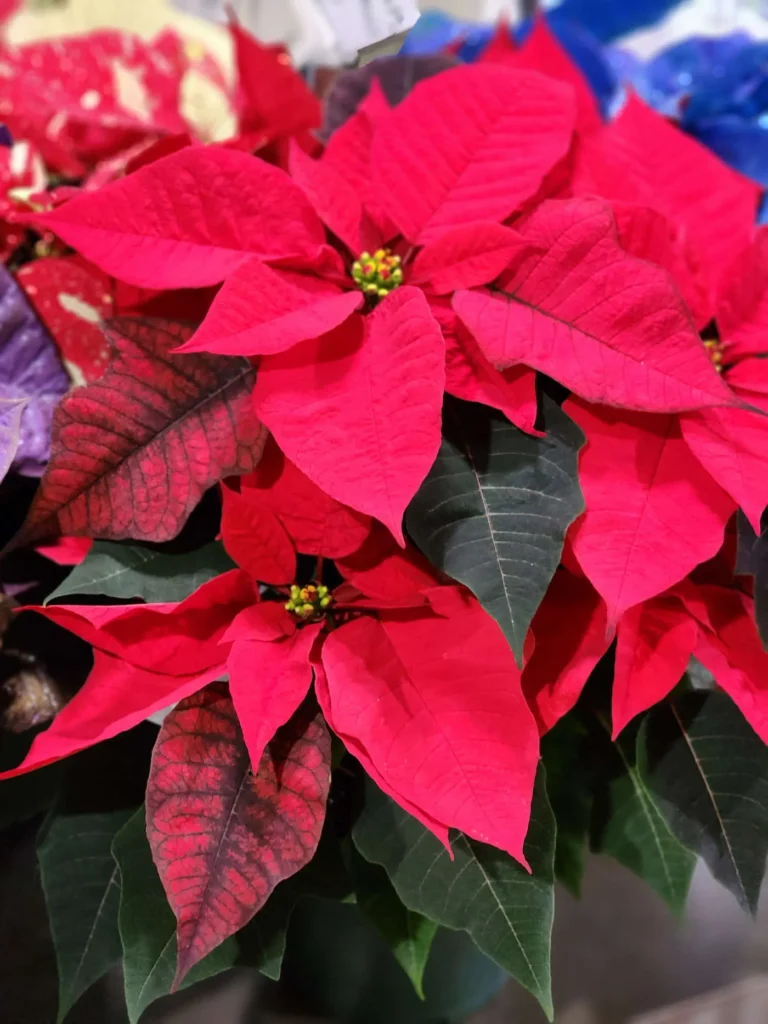Poinsettia Care
Poinsettia is a brilliant potted plant that makes a bold statement with its colorful bracts and yellow flowers. This Christmas classic is native to the tropics and thrives in bright light with warmer temperatures and humidity. Though many people receive poinsettias as a gift around the holiday season and dispose of them after they finish blooming, these plants can make an eye-catching addition all year round. With the right care, you can encourage this vibrant perennial to rebloom for many years to come.

How to care for your Poinsettia
- LIGHT
Poinsettias love bright but indirect sunlight. An eastern window is ideal, or a few feet back from a southern or western window. Watch out for pale bleached leaves as this is a sign your plant is getting too much direct sun.
- WATER
You should water your poinsettia when the top 50% of soil is dry. Water slowly until you see water begin to trickle out of the pot’s drainage hole, and make sure you let excess water fully drain out. Discard any excess water after a few minutes.
- HUMIDITY
Poinsettias enjoy humidity between 50% – 75% ambient humidity. You can boost humidity by misting, adding a pebble tray, or placing a humidifier nearby.
- TEMPERATURE
Poinsettia flowers appreciate daytime temperatures between 65-75° F and nighttime temperatures of 55-60° F. Keep your poinsettia away from drafty windows or doors, and any open vents.
- FOOD
You can give your poinsettia a boost with fertilizer for flowering plants. Fertilize once a month after the plant begins growing again in the spring and throughout the growing season and into the fall. No fertilizer is needed during the winter months.
- TOXICITY
Toxic only if ingested in very high amounts to pets and humans. The sap can be irritating to the mouth and stomach if ingested, sometimes causing vomiting. The sap may also cause a very mild allergic skin reaction in some people.
- ADDITIONAL CARE
To encourage your plant to take on a full, bushy shape, prune the stems back in spring and allow the plant to flush out new growth. To encourage the plant to rebloom, ensure the plant receives complete darkness for 14 hours a day for a span of 8 weeks, beginning in mid to late September. This signals the plant to begin producing flower buds and colorful bracts in time for the holiday season.
Common Issues for your Poinsettia
Watering
Water when the top 50% of the soil is dry. Watering too often to create soggy soil leads to root rot, but letting your poinsettia get bone dry can cause the roots to dry back. Water thoroughly until it flows out of the drainage hole and discard any excess water.
Lighting
Your poinsettia prefers indirect, but bright light. Too much light will cause the foliage to get crispy and brown, but too little light will cause yellow leaves. An eastern window is perfect for this plant, or a little further back from a southern or western window works as well.
Temperature
These tropical plants like consistent warm temperatures. Be sure to keep your poinsettia away from any drafty areas or open vents. A sudden change in temperate will cause your plant to go into shock.
Improper Fertilization
Plant fertilizer can give your potted plants a boost, but only when used properly. If you over-fertilize or apply incorrectly, you can burn your plant’s roots. Fertilize after the plant begins growing again in the spring, and then once a month during the growing season. No fertilizer is needed during the winter months. Never apply fertilizer to dry soil.
Watering
Water when the top 50% of the soil is dry. Watering too often to create soggy soil leads to root rot, but letting your poinsettia get bone dry can cause the roots to dry back. Water thoroughly until it flows out of the drainage hole and discard any excess water.
Lighting
Your poinsettia prefers indirect, but bright light. Too much light will cause the foliage to get crispy and brown. An eastern window is perfect for this plant, or a little further back from a southern or western window works as well.
Temperature
These tropical plants like consistent warm temperatures. Be sure to keep your poinsettia away from any drafty areas or open vents.
Humidity
If you notice your poinsettia leaves start to curl and brown at the times, it might need a humidity boost. Try misting, adding a pebble tray, or placing a humidifier nearby.
